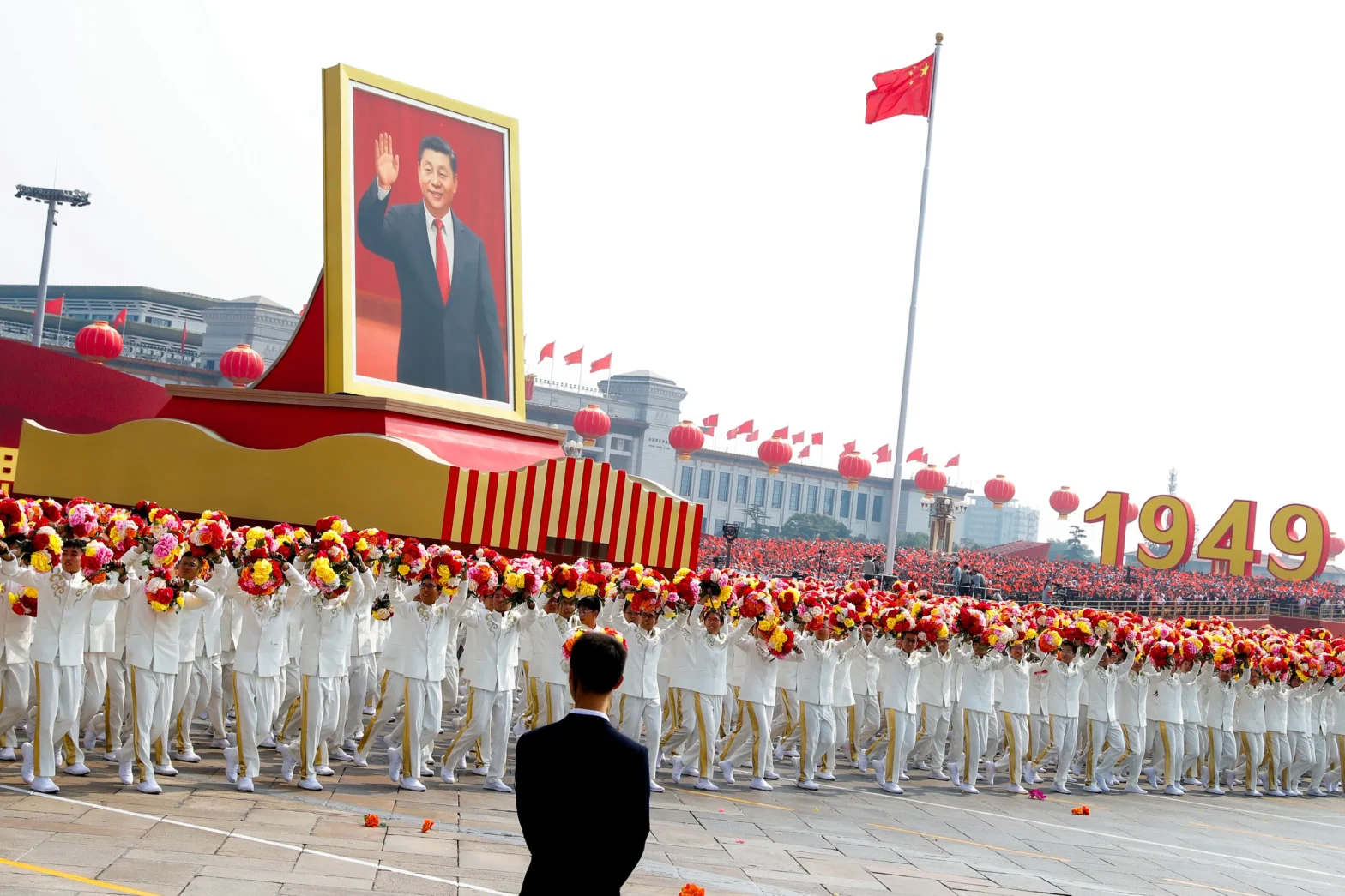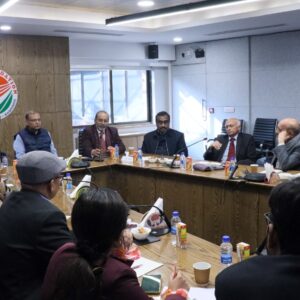China’s one-party state is often seen as having an easier governance task compared to democracies, where daily struggles between ruling and opposition parties can cause delays in policy making and implementation. However, the Chinese leadership of the Chinese Communist Party (CCP) also faces a complex environment, trying to manage internal socio-economic and political issues alongside an increasingly assertive foreign policy. At home, China continues to deal with an economic slowdown, high youth unemployment and an ageing population, all of which put pressure on social welfare systems. According to a poll by Reuters, China’s gross domestic product (GDP) is expected to slow to 4.5% in the third quarter and to 4.0% in the fourth, highlighting growing economic challenges, as U.S. President Donald Trump’s global trade war expands, and Beijing faces the task of encouraging households to spend more during a time of uncertainty[1].
The property crisis in China, exemplified by the collapse of giants like Evergrande, on the other hand, erodes public confidence and local government revenues. As people see unfinished projects and rising mortgage defaults, the crisis erodes people’s confidence, while local governments lose significant land sale revenues and face increased fiscal pressure.
The real estate market is one of the most influential drivers of China’s economic growth. However, the crisis within it has caused financial difficulties for local governments. Chinese local governments mainly rely on taxes and revenue from land use rights sales for funding. Nonetheless, their income has declined due to the downturn in the real estate market, which has increased the risk that local government financing vehicles, or special companies that fund infrastructure projects using government assets as collateral, will default[2]. The debts of local government lending organisations are referred to as hidden costs because they are not included in official government statistics, and the International Monetary Fund (IMF) in 2023 estimated that the debts of local government lenders made up 53% of the country’s GDP[3].
Social inequalities in China still exist, especially in rural areas, despite claims of poverty reduction. China actually has one of the largest rural-urban income gaps in the world. Although rural-urban migration has increased, the urban-rural divide continues to grow. Remittances sent home have become a significant part of rural incomes, with almost USD 51 billion sent in 2022 alone, but research by Wuhan University indicates much remains to be done[4]. As the divide widens, the risk of China remaining trapped in the middle-income trap increases, and closing this gap effectively is crucial for the country’s development, especially as China faces multiple economic headwinds.
Politically, the CCP maintains strict control and prioritises stability through censorship, surveillance, and crackdowns on anything the Party perceives as dissent. Xi Jinping’s consolidation of power, along with penalising even Party members who are seen as diverging from the official Party line, raises concerns about long-term governance risks. China also has global ambitions, as shown by initiatives like the Belt and Road Initiative (BRI), which seeks to expand Chinese geopolitical influence to secure economic dominance by heavily investing in infrastructure and trade networks across Asia, Africa, and Europe. These projects, although under grave suspicion from several countries, require significant financial commitments, with estimates suggesting that China has already spent USD 1 trillion on BRI-related initiatives since 2013, mainly funded through state-backed loans and investments[5].
However, the BRI has also generated opposition. For some countries that take on large amounts of debt to fund infrastructure upgrades, BRI funds have been viewed as a potentially toxic source. For China, BRI projects are a commercial endeavour[6]. Loans are provided at a rate close to the market interest rate, which China expects will be fully repaid.
However, BRI investments involve opaque bidding procedures and necessitate the involvement of Chinese firms[7]. Consequently, contractors inflate costs, resulting in cancelled projects and political backlash[8]. Nevertheless, China cannot abandon the BRI since it is enshrined in the Constitution of the CCP[9]. Any reversal of the BRI will not only result in at least a trillion dollars worth of lost investments but also damage the CCP’s reputation. Still, extensive spending strains China’s domestic budget and limits resources for social welfare programmes like healthcare and education. To sustain economic stability, China often prioritises foreign investments over domestic infrastructure upgrades, which causes uneven regional development and exacerbates inequalities.
Beyond the need to service foreign debt and manage foreign currency reserves, Beijing is driven to implement tighter fiscal policies, which in turn limit domestic economic reforms and social spending. To understand the ongoing struggle that the CCP faces in balancing its global ambitions with the allocation of revenues and attention to domestic issues, this essay is divided into sections covering current domestic challenges facing China, South China Sea and regional tensions, the U.S.-China rivalry, China’s global governance ambitions, its resource allocation dilemma, internal dissent and external image, followed by a conclusion outlining its future outlook. The article relies on both primary and secondary sources to analyse how China attempts to balance domestic hurdles with its global ambitions.
China’s current domestic challenges in 2025
China’s economic growth has slowed, according to IMF data. Its GDP growth dropped to 4.7% in the second quarter of 2024, influenced by a property sector crisis, falling exports, and poor consumer demand[10].
The economic slowdown in China strains job creation and public welfare, weakening the social contract of prosperity in exchange for political loyalty. By July 2024, China’s youth unemployment reached 17.1%, up from 13.2% in June, increasing discontent among graduates in a challenging environment marked by a property crisis and declining domestic demand. The rate is the highest since China introduced and adopted a new methodology. This new methodology for calculating the youth unemployment rate was introduced in January 2024 and excludes university students from the calculation. The change was made after youth unemployment surged, and the calculation was temporarily suspended in 2023 while the government aimed to improve the statistical methodology[11]. However, the unemployment rate still soared in 2024. The situation is worsened by a mismatch between job expectations and available positions, leading to frustration among the youth[12].
A major contributing factor is the impact of the zero-COVID policies, which led to the shutdown of many small and medium-sized businesses[13]. The struggle for the CCP in this context cannot be overlooked. Therefore, on 8 April this year, China’s General Office of the Communist Party Central Committee and General Office of the State Council jointly issued guidelines aimed at creating a high-quality employment services system for university graduates[14]. Nevertheless, this is not the first time the CCP has had to implement such policies. The following table displays some of the recent policies in China aimed at creating employment for youth.
Table 1: Some examples of Chinese policies from the recent past to generate employment for the youth.
| Number | Policy | Brief description |
| 1. | Higher Education Expansion | In 1999, China launched a higher education expansion policy to increase enrollment and produce more skilled graduates. While this boosted economic growth it led to an oversupply of graduates, contributing to graduate unemployment and underemployment. |
| 2. | Vocational and General Education Reforms | he government focused on improving the quality and relevance of general and vocational education to better prepare youth for the labor market. Policies emphasized matching labor supply with demand and easing school-to-work transitions. |
| 3. | Financial Incentives and Subsidies | Amidst the shifting economic landscape in 2024, over 100 billion yuan in employment subsidies were allocated to support individuals and employers, benefiting over 2 million college graduates. Financial inducements for businesses, tax cuts, and low-interest loans were introduced to encourage hiring and job creation in growth industries. |
| 4. | Targeted Support for College Graduates | In response to a record 11.7 million college graduates in 2024, policies focused on tailored job services, career guidance, and placement programs for graduates and migrant workers.
New measures announced in March 2025 aimed to bolster opportunities in emerging industries and enhance vocational skills training to address evolving job market demands. |
| 5. | Local Employment Projects and Entrepreneurship | In 2024, the CCP government promoted entrepreneurship through guidance and financial support, encouraging youth to start businesses as an alternative to traditional employment. |
Source (s): Various news reports
These policies have been ongoing, indicating that the challenge persists indefinitely. However, allocating funds is not an easy task, given that Beijing also needs to manage its global ambitions. In this context, an analysis of China’s South China Sea ambitions, the losses it faces from the U.S.-China rivalry, and the impacts on its BRI deserve closer scrutiny.
South China Sea and Regional Tensions
China’s assertiveness in the South China Sea has increased significantly. Its aggressive actions have heightened tensions with several Southeast Asian countries, particularly with the Philippines at the Second Thomas Shoal in the Spratly Islands. China’s actions, including ramming, water cannon usage, harassment, and militarised patrols, all aim to assert dominance over disputed areas, especially within China’s “nine-dash line” claim, which was invalidated by a 2016 tribunal in The Hague. Table 2 below shows representative actions by the Chinese Navy in the South China Sea between January and August this year.
Table 2: China’s aggressive tactics in the South China Sea in 2025.
| Number | Month | Brief description |
| 1. | January 24, 2025 | Chinese coastguard vessels and a People’s Liberation Army Navy (PLAN) helicopter harassed Philippine fisheries vessels within the Philippines’ exclusive economic zone (EEZ). This involved low-altitude hovering and blocking maneuvers, endangering civilian boats. Chinese sources described it as routine patrols to prevent illegal fishing. |
| 2. | April 2025 | China deployed the Shandong carrier task group through the Luzon Strait into the Western Pacific- the second such deployment in 2025- positioning east of the Philippines. This was seen as a message to Manila amid U.S. anti-ship missile deployments in the area. |
| 3. | May 2025 | Two PLAN frigates and a Chinese coastguard cutter harassed a Philippine Navy warship, using blocking and shadowing tactics. |
| 4. | June 2025 | The Philippine Navy reported 49 Chinese vessels in three disputed areas- the highest monthly total in 2025- including naval, CCG, and militia ships. Expanded patrols east of Scarborough Shoal intercepted Philippine ships, leading to frequent encounters. |
| 5. | July 2025 | U.S. commanders reported China’s tactics growing “steadily more aggressive,” including rammings, water cannons, and lasers against Philippine vessels. Beijing’s campaign of intimidation was described as having “run aground” due to Philippine resistance and international support. |
| 6. | August 2025 | China ramped up PLAN and Chinese coast guard activities, including drills, to counter Philippine-Indian naval patrols. Additionally, a PLAN destroyer and Chinese coast guard vessel collided while pursuing the Philippine patrol vessel BRP Suluan, causing significant damage. This followed water cannon use and was described as reckless by Philippine sources; China called it lawful interception after ignored warnings.
In August yet again, China’s military claimed it “drove away” the US destroyer USS Higgins from waters near the Scarborough Shoal, asserting the destroyer entered without Chinese government approval. In contrast, the U.S. Navy defended the action as a lawful assertion of freedom of navigation under international law, stating it had the right to operate where international law permits. |
Source (s): Various news reports
It is evident from the examples from 2025 alone that China must allocate a substantial amount of money to its military activities in the South China Sea. In 2023, it was reported by Reuters that China had spent about USD 15 billion, or 7% of its defence budget, on exercises in the Western Pacific[15].
China has invested heavily in land reclamation and construction in the Spratly Islands since 2013, creating over 3200 acres of artificial land. This involves building airstrips, radar installations, and missile facilities, which enhance China’s military posture in an effort to project power across the South China Sea[16]. China’s national military budget for 2025 was set at 1.78 trillion Yuan, roughly about USD 246 billion, making it the second largest in the world. The expenses for its South China Sea activities, including the building of artificial islands and military exercises, are part of this budget. The increase in the national defence budget has been 7.2% compared to last year[17]. The odd part is, that as China’s economy slows, plagued by numerous problems, its military budget grows.
The South China Sea dispute is one of many conflicts involving China. China is engaged in territorial disputes with at least 17 countries, covering both land and maritime issues. Military aggression makes up a significant part of China’s defence budget.
The U.S.-China economic rivalry and its impact on China’s economic growth
The trade war with the U.S. has affected its economic growth, and according to analysts at RAND, the GDP is declining by approximately 0.3% to 0.6% each year[18].
In the case of a sustained embargo-level trade war, the private sector may suffer a greater blow. Reduced exports, disrupted supply chains, and slowing economic growth in China have led companies to diversify production, prompting the CCP government to implement policy adjustments. The Chinese economy has so far shown signs of resilience; however, the uncertainty created for foreign companies in China cannot be overlooked. Additionally, there has been a dampening of investor confidence and a broader reassessment of global economic interdependence[19].
In the first quarter of 2025, growth remained steady at 5.4% year-on-year, but by the second quarter it dipped slightly to 5.2%, supported by infrastructure spending and consumer subsidies, as well as interest rate cuts, amid reduced demand. Considering a 1.2% drain from tariffs, the projections for 2025 are around 4.5%[20]. One of the most severe impacts is on employment, as tariffs harm the growth based on an export-dependent strategy. In export-oriented coastal regions like Guangdong, the impact is more severe, with estimates indicating a job loss of 16 million, approximately 2% of China’s 734 million workforce[21].
Consumer prices fell in China during April 2025 despite stimulus efforts[22]. This reflects tightening budgets amid job uncertainty and a bleak economic outlook, which further dampens demand. Factory prices are in deflation, and the Chinese economy is stuck in a deflationary spiral. According to Goldman Sachs’ estimates, in 2025, China’s retail inflation will drop to 0% from a 0.2% year-on-year increase in 2024, and wholesale prices are expected to decline by 1.6%, compared to a 2.2% decrease last year[23].
Adding to this, U.S. companies have reduced investments in China to record lows, influenced by tariffs and geopolitical tensions. Foreign direct investment is fleeting and has also been at record lows[24]. The geopolitical and geoeconomic competition with the U.S. adds to China’s problems, increasing the burden on the CCP to balance global ambitions and domestic needs.
The BRI, on which China has spent an estimated USD 1.308 trillion since its inception in 2013, is also on shaky ground[25]. While the BRI aims to reshape global governance, it faces several challenges including issues with debt sustainability, poor risk management and execution, negative social impacts in recipient countries, corruption, political resistance, and funding shortages. Given the shifts in geopolitical dynamics, promoting China’s rise as the leader of the current international system carries multiple costs, which, considering the turmoil in the domestic economy, require recalibration by the CCP.
Conclusion
China’s dual pursuit of internal stability and global ambitions poses a complex challenge for the CCP. China’s economic slowdown, as shown by its GDP figures, highlights the difficulty of balancing domestic socio-economic issues with an assertive foreign policy. The property crisis, exemplified by the collapse of Evergrande, undermines public confidence and leads to a decline in local government revenues. High youth unemployment, which reached 17.1% in July 2024, increases discontent among graduates. The significant rural-urban income gap, one of the highest worldwide, risks trapping China in the middle-income trap and jeopardises long-term development.
These domestic challenges require the allocation of substantial resources, yet China’s ambitions, as demonstrated through its increased assertiveness in the South China Sea and its investments in BRI projects, compete for the same financial and political capital of the CCP and the country. A defence budget of USD 246 billion diverts resources from domestic needs, worsening inequalities and restricting social welfare investments. The U.S.-China trade war further complicates matters, leading to job losses, especially in manufacturing. Falling consumer prices and deflationary pressures in 2025 highlight weakened domestic demand, while decreased FDI indicates waning investor confidence.
The CCP thus faces a delicate balancing act. Prioritising global initiatives like the BRI and South China Sea dominance, for example, risks neglecting domestic challenges, potentially undermining the social contract between the state and its citizens. Conversely, focusing on internal reforms could also weaken China’s global standing, especially as the BRI is enshrined in the CCP Constitution. The future of China depends on the CCP’s ability to harmonise these competing priorities, ensuring that economic stability and social cohesion take precedence. China is skilled at learning from its history. Amidst shifting geopolitical winds, China may very well revert to Deng Xiaoping’s policies of hiding one’s powers and biding one’s time, while exploring other export markets, and engaging in posturing and optics to ensure it can leverage other markets beyond those in the West, including the ones it routinely confronts with aggression.
Once China rebuilds its internal cohesion, similar to the 1970s and early 1980s when it relied on the West, Japan, South Korea, and India, it will re-emerge and pursue its ambition to lead the current international order. While this remains a prediction, it is clear that China is undertaking recalibrations and reformulating policies. The world, especially those with which China has experienced hostility—be it militarily or economically—must be cautious about how they engage with a China that carefully balances its own priorities and global ambitions. China often promotes win-win outcomes, but the results frequently turn out to be the exact opposite of mutual gains.
Author Brief Bio: Dr. Sriparna Pathak is a Professor of China Studies at O.P. Jindal Global University. She is also a Senior Fellow at the Jindal India Institute, and can be reached at sriparnapathak@gmail.com.
[1] https://www.reuters.com/world/china/chinas-gdp-growth-set-slow-raising-pressure-policymakers-2025-07-11/#:~:text=China’s%20GDP%20growth%20set%20to%20slow%2C%20raising,policy%20rate%20by%2010%20bps%20in%20Q4.
[2] https://english.hani.co.kr/arti/english_edition/e_international/1104836.html
[3] Ibid
[4] https://english.ckgsb.edu.cn/knowledge/article/growing-closer-chinas-rural-urban-divide-and-its-effects/#:~:text=%E2%80%9CThe%20simplest%20solution%20is%20to,%2C%20you%20need%20people%20there.%E2%80%9D
[5] https://www.cfr.org/backgrounder/chinas-massive-belt-and-road-initiative
[6] https://docs.aiddata.org/ad4/pdfs/Banking_on_the_Belt_and_Road_Executive_Summary.pdf
[7] https://documents1.worldbank.org/curated/en/715511560787699851/pdf/Main-Report.pdf
[8] https://www.cgdev.org/article/china%E2%80%99s-massive-belt-and-road-initiative-council-foreign-relations
[9] https://www.idcpc.gov.cn/english2023/dzwk/zgkx/202307/P020230717028554589528.pdf
[10] https://www.reuters.com/markets/asia/chinas-economy-seen-slowing-q2-stimulus-calls-grow-2024-07-14/#:~:text=Summary,for%20Greater%20China%20at%20ING.
[11] https://www.wsj.com/economy/jobs/chinas-youth-jobless-rate-edges-higher-after-methodology-change-4a969225
[12] https://stratnewsglobal.com/world-news/chinas-youth-seek-govt-jobs-opt-for-vocational-courses/
[13] https://www.chinacenter.net/2023/china-currents/22-1/the-covid-19-pandemics-impact-on-the-chinese-economy/
[14] https://opportunities-insight.britishcouncil.org/short-articles/news/china-releases-new-policies-improve-graduate-employment#:~:text=On%20April%208%2C%202025%2C%20China’s,emphasises%20entrepreneurship%20and%20strategic%20sectors.
[15] https://www.reuters.com/world/asia-pacific/china-spent-153-bln-pacific-exercises-2023-internal-taiwan-estimates-show-2024-08-27/#:~:text=On%20Assignment-,Exclusive:%20China%20spent%20$15.3%20billion%20on%20Pacific%20exercises%20in%202023,around%20Taiwan%20and%20its%20neighbours.
[16] https://pppescp.com/2024/12/09/the-south-china-sea-a-complex-historical-and-geopolitical-landscape/#:~:text=China’s%20Strategy:%20%E2%80%9CCabbage%20Tactics%E2%80%9D%20and%20Expanding%20Presence&text=Since%202013%2C%20China%20has%20also,over%20territorial%20claims%20%5B8%5D.
[17] https://www.thehindu.com/news/international/china-will-increase-its-defence-budget-72-in-2025/article69295050.ece
[18] https://www.rand.org/pubs/commentary/2025/06/testing-self-reliance-what-the-trade-war-reveals-about.html
[19] https://www.juliusbaer.com/en/insights/market-insights/market-outlook/us-china-trade-war-escalation-what-investors-need-to-know/
[20] https://www.chinausfocus.com/finance-economy/the-impact-of-the-tariff-war-on-the-chinese-economy
[21] https://www.rand.org/pubs/commentary/2025/06/testing-self-reliance-what-the-trade-war-reveals-about.html
[22] https://www.bloomberg.com/news/articles/2025-05-28/china-deflation-worry-deepens-among-economists-after-trade-truce
[23] https://www.cnbc.com/2025/05/05/china-risks-deeper-deflation-by-diverting-exports-to-domestic-market.html#:~:text=China%20risks%20a%20spiral%20into%20deeper%20deflation,economic%20deterioration%20before%20it%20exercises%20fiscal%20firepower.
[24] https://www.weforum.org/stories/2025/07/tariff-impacts-us-companies-cut-investments-china-record-lows/
[25] https://greenfdc.org/china-belt-and-road-initiative-bri-investment-report-2025-h1/





